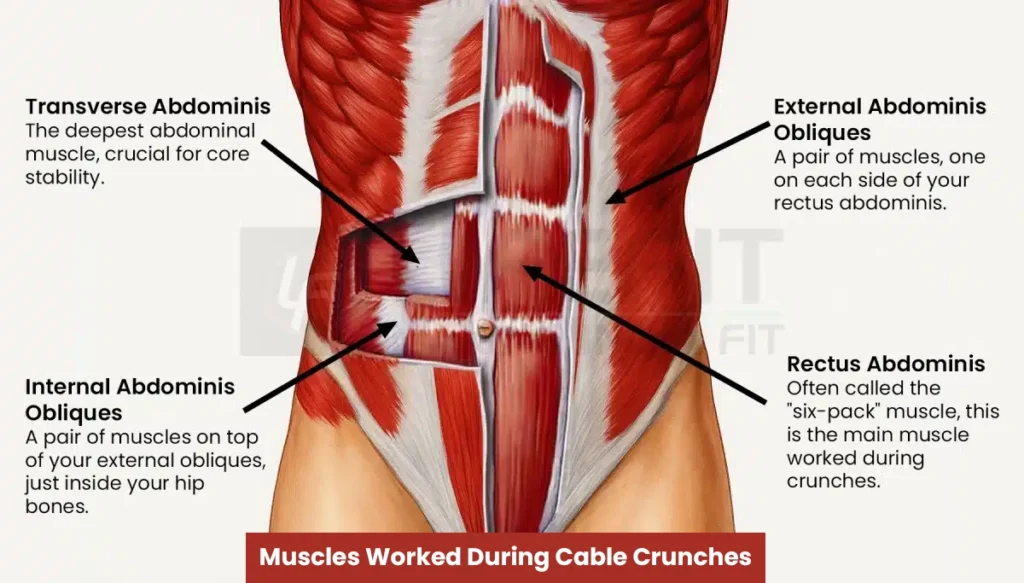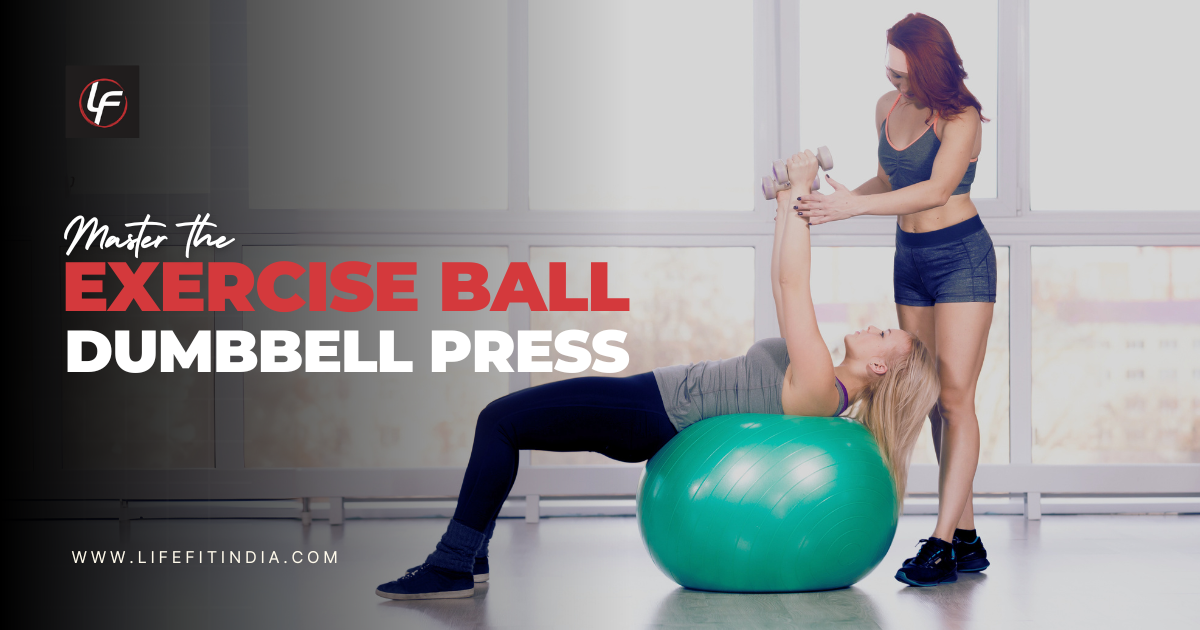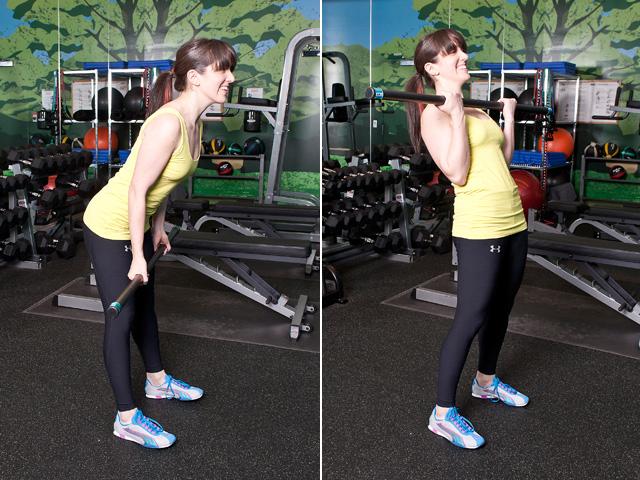
Are endless floor crunches failing to build the strong, defined abs you want? The cable crunch might be the missing link in your core training. While traditional crunches have their place, the cable crunch offers a superior method for applying progressive overload, the fundamental principle for driving muscle growth that is often a limitation in bodyweight ab exercises.
This guide provides a comprehensive look at the cable crunch, covering not just the “how-to” but also the deep science behind safety, muscle activation, and athletic programming.
What is a Cable Crunch and Why Is It So Effective?
The cable crunch is a weighted abdominal exercise performed with a cable machine. It stands out from traditional crunches for two primary reasons that are critical for muscle development.
Constant Tension: Unlike a floor crunch where tension can decrease at the top and bottom of the movement, a cable machine provides consistent resistance throughout the entire range of motion. This increases the muscle’s time under tension, a key factor for stimulating muscle growth (hypertrophy).
Progressive Overload: The ability to incrementally increase the weight on the machine’s stack is crucial for long-term strength and muscle gain. This directly overcomes the main limitation of bodyweight exercises, which your body eventually adapts to. A study on the crunch exercise confirmed that increasing external load leads to significantly greater recruitment of the abdominal muscles, providing a scientific basis for this benefit.
To perform this exercise, you will need a machine like a Functional Trainer or a Cable Crossover.
The Definitive Guide to Perfect Cable Crunch Form
This section consolidates the best cues to provide a detailed guide to proper execution.
Equipment Setup
- Machine & Pulley: Set the pulley to the highest position on the cable machine.
- Attachment: The rope attachment is the recommended choice as it allows for a neutral grip and the option to twist to engage the obliques.
- Knee Comfort: Kneel on a folded exercise mat or a Yoga Mat for comfort and stability.
Step-by-Step Execution
- The Starting Position: Kneel down facing the machine, grasp the rope attachment, and position your hands beside your face or forehead. Kneel far enough from the machine to create a counterbalance with the weight.
- Hip and Spine Alignment: This is the most critical step. Lock your hips in a high position, keeping your thighs perpendicular to the floor. This isolates the abdominals and prevents the powerful hip flexors from taking over. Your spine should start in a neutral or slightly extended position to allow a full stretch of the abs.
- The Contraction (Concentric Phase): Exhale and initiate the movement by flexing your spine, thinking of bringing your rib cage toward your pelvis. Your arms should act only as hooks; do not pull the weight with them.
- The Peak Contraction: Pause briefly at the bottom of the movement and focus on squeezing your abdominal muscles as hard as possible.
- The Return (Eccentric Phase): Inhale as you slowly and controllably return to the starting position. This controlled negative movement is vital for muscle growth. Do not let the weight stack touch down between reps to maintain continuous tension.
The Role of Breathing
The correct breathing pattern is to exhale during the crunching phase (concentric) and inhale during the return (eccentric). For a more intense contraction, you can perform a forceful exhalation at the point of the peak squeeze.
Muscles Worked in the Cable Crunch

This exercise primarily targets the core musculature.
- Primary Movers: The rectus abdominis, often called the “six-pack” muscle, is the main muscle responsible for spinal flexion during the crunch.
- Secondary & Stabilizing Muscles: The internal and external obliques stabilize the torso, while the deep transversus abdominis acts as the body’s natural weight belt, providing core stability.
The Mind-Muscle Connection: How to Truly Feel Your Abs Working
A common issue is feeling the exercise in the arms or back instead of the abs. This is where the mind-muscle connection (MMC) becomes important. MMC is the conscious focus on a specific muscle to enhance its activation.
Science-Backed Techniques to Boost Abdominal Activation
- Internal Focus Cues: Instead of just thinking about moving the weight, focus on the muscle itself. For example, “imagine your abs are a sponge, and you are squeezing out every drop of water.” Research in the European Journal of Sport Science has shown that using an internal focus of attention can lead to greater muscle activity.
- Tempo Training: Slow down the movement, especially the return phase. A 3-1-3 tempo (3 seconds down, 1-second pause, 3 seconds up) increases time under tension and improves focus.
- Pre-Activation Drills: Perform a simple bodyweight crunch or a short plank before your cable crunches to “wake up” the neuromuscular pathways to your abs.
The Great Debate: Are Cable Crunches Safe for Your Back?
While some sources warn against spinal flexion, a nuanced, evidence-based discussion is necessary.
The Biomechanics of Spinal Flexion
Flexing the lumbar spine, as in a crunch, does increase compressive forces on the intervertebral discs. Some research has highlighted that traditional sit-ups can impose significant compression on the spine.
A point-counterpoint paper in the Strength and Conditioning Journal provides a balanced scientific discussion.
- The “Risk” Perspective: This view suggests that repeated, end-range spinal flexion could theoretically contribute to disc issues over time, especially for those with pre-existing conditions.
- The “Benefit” Perspective: This argument counters that living tissue is adaptive and grows stronger with stress. The cable crunch involves a limited range of motion, imposing less stress than the end-range flexion used in some lab studies. Some research also suggests the pumping action of flexion may improve nutrient delivery to the discs.
The Expert Verdict
For individuals with a healthy spine, the cable crunch is a safe and effective exercise when performed with perfect form and appropriate weight. However, anyone with a history of disc herniation or other specific back pathologies should consult a medical or physical therapy professional.
You can also explore exercises for back pain that may be more suitable. Proper form, especially locking the hips, is the most critical factor in mitigating potential risk.
Programming the Cable Crunch for Your Goals
How you program the exercise determines the results. Training for muscle size (hypertrophy) requires a different approach than training for maximal strength or endurance. This can be integrated into broader workout routines for men or women.
Actionable Cable Crunch Protocols
Cable crunches can be programmed effectively to support different training goals by adjusting intensity, repetitions, sets, and rest periods. Below are structured guidelines tailored for hypertrophy, strength, and endurance.
1. Muscular Hypertrophy
- Goal: Increase abdominal muscle size and definition
- Intensity: Moderate (7–8 RPE)
- Repetition Range: 8–15 reps
- Sets: 3–5
- Rest Period: 60–90 seconds
- When to Perform:
- Mid-workout
- During a hypertrophy-focused training block
- Key Focus: Muscle contraction and time under tension
2. Maximal Strength
- Goal: Build strong, powerful core muscles
- Intensity: Heavy (8–9 RPE)
- Repetition Range: 4–8 reps
- Sets: 3–4
- Rest Period: 2–3 minutes
- When to Perform:
- At the beginning of your workout (when fresh)
- Within a strength-specific training phase
- Key Focus: Controlled movement with heavier resistance
3. Muscular Endurance
- Goal: Improve core stamina and maintain form under fatigue
- Intensity: Light (5–6 RPE)
- Repetition Range: 15–20+ reps
- Sets: 2–3
- Rest Period: 30–60 seconds
- When to Perform:
- At the end of a workout as a finisher
- During endurance or circuit training blocks
- Key Focus: Consistent form and full range of motion over longer durations
Common Mistakes and How to Fix Them
- Pulling With Your Arms
- The Problem: Using your arms to pull the weight instead of using your abs to crunch.
- The Fix: Reinforce the cue of the arms being just “hooks.” The movement must start from the spine.
- Swinging With Your Hips
- The Problem: Rocking your hips back and forth, which uses momentum and shifts the load to the hip flexors.
- The Fix: Lock the hips in place. If you cannot, the weight is too heavy.
- Using Too Much Weight
- The Problem: “Ego-lifting” leads to poor form and reduces the quality of the stimulus for the abs.
- The Fix: Choose a weight that allows you to complete your target reps with perfect, controlled form.
- Rushing the Repetitions
- The Problem: Using momentum reduces the muscle’s time under tension.
- The Fix: Control the upward (eccentric) phase of the movement, resisting the pull of the weight stack.
Cable Crunch Variations and Alternatives
- For Increased Stability: The seated cable crunch is a great option for beginners or those with knee discomfort. An ab crunch machine also offers maximum stability.
- For Increased Dynamic Control: The standing cable crunch is an advanced variation that requires more total-body core stability.
- For When You Don’t Have a Cable Machine:
- A weighted crunch using hex dumbbells or a plate is a direct alternative.
- A resistance band crunch can mimic the cable machine’s resistance.
- Stability ball crunches are highly effective. A study in the Journal of Orthopaedic & Sports Physical Therapy showed that exercises on a Swiss ball can significantly increase abdominal activation compared to traditional exercises on a stable surface.
Frequently Asked Questions (FAQs)
How often should I train abs with cable crunches?
Training abs with resistance 1-3 times per week is recommended, allowing for adequate recovery.
Will cable crunches give me a six-pack?
They are effective for building the abdominal muscles, but muscle visibility (a “six-pack”) is primarily determined by having a low body fat percentage, which requires a proper nutrition plan. For more tips, see our guide on how to get a flat belly.
Will cable crunches make my waist thicker?
It is highly unlikely. While the ab muscles will grow, they typically do not add substantial size to the waistline unless training is combined with a significant calorie surplus.
Should I do cable crunches at the beginning or end of my workout?
If core strength is a priority, perform them early when you are fresh. For hypertrophy or endurance, they can be done effectively toward the end of your session.
Conclusion
The cable crunch is a premier exercise for abdominal development due to its capacity for constant tension and progressive overload. By mastering form, leveraging the mind-muscle connection, understanding spinal safety, and applying structured programming principles, you can use this exercise as a strategic tool to break through plateaus and build a truly powerful core.














































